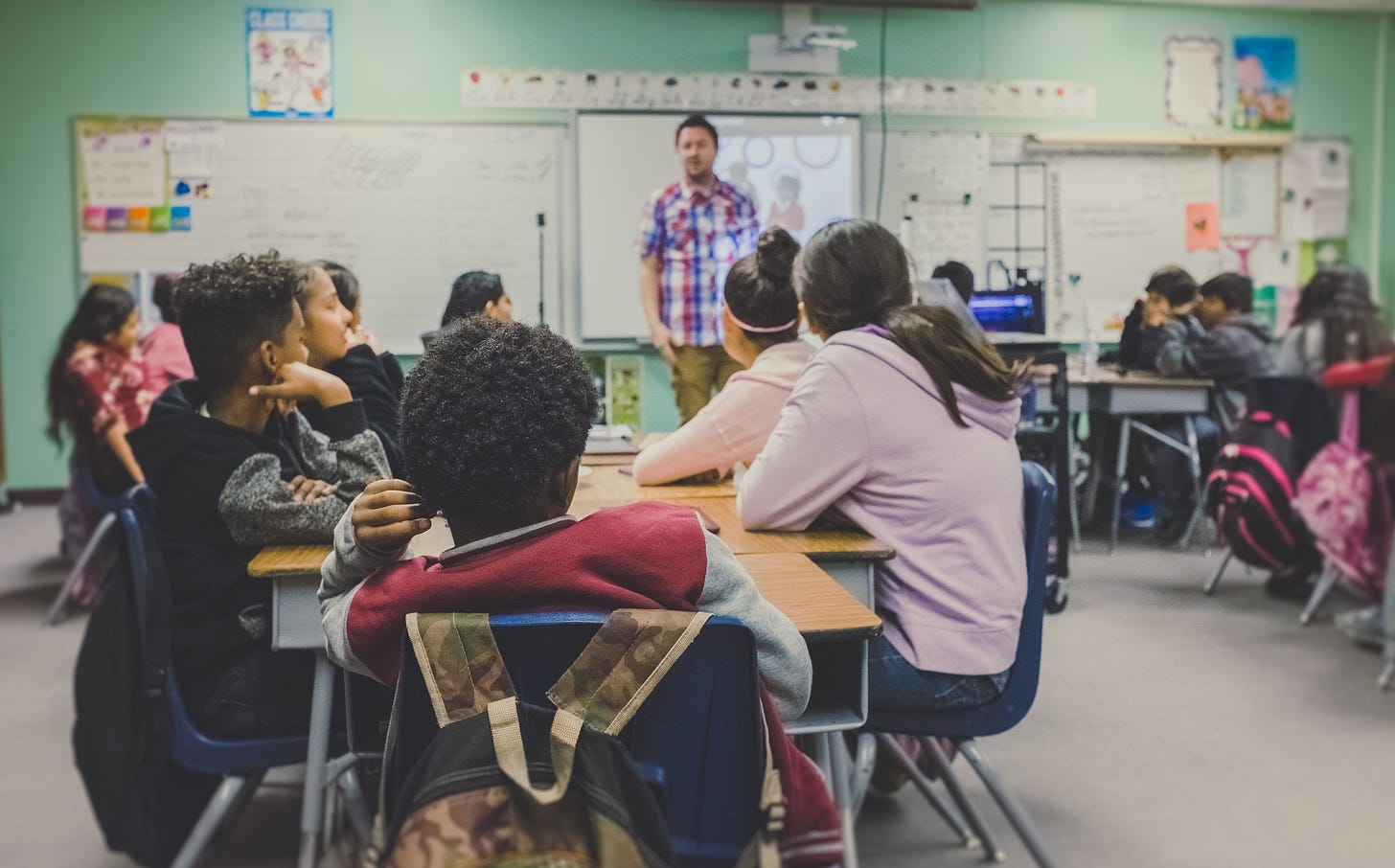Photo by Kenny Eliason on Unsplash
Sometimes I do things just because it might make a good article. Or a newsletter. Or a blog post.
When I was writing regularly for education publications, I was always scouring social media and talking to sources to find fresh ideas about schools. At the beginning of 2022, the covid crisis was over and schools were open — all great news — but schools were reeling from a huge staffing crisis. Many teachers left, because they didn’t want to go back in the classroom. And schools couldn’t find workers for their lowest wage jobs — bus drivers, substitute teachers, and classroom aides. Those folks suddenly made more money working in Amazon warehouses and making coffee in Starbucks, so they all quit.
So, I decided to get my substitute license to see if the process for getting the license was also discouraging people. Might make a good article, I thought.
What did I find out? Well, the entire process for getting a substitute license took six months. I had to pay about $200 for all the licenses requirements for a job that paid about $100 a day. I had to get fingerprinted at a mini-mall about 40 minutes from my house twice, because I have bad fingerprints that didn’t work the first time. I had to wait two weeks for the school board to approve my application.
It was a hassle, for sure, but my notes were too boring to turn into a 1,200 word story. No one would read an article about me filling out paperwork for months.
By the fall of 2022, I had a substitute teaching license and no article. What the hell, I thought. I’ll do it. So, I stepped away from drafting my articles on my computer one day a week and worked as a substitute aide in a local elementary school. And I loved it!
I mostly worked in the autism classroom, because nobody else wanted to do it. Working with those those kids and staff was truly lovely, but too many people are scared off by labels and don’t give it a try. I have stories about that experience, but I think I’ll keep those to myself for the moment. When the autism classrooms didn’t need help, I supported the regular classrooms.
For the most part, elementary school has not changed in fifty years. Worksheets, playground, recess, cardboard pizza for lunch, library, circle time on the floor.
Seriously, no changes at all. Except for technology.
Unlike my classrooms from the 70s, every classroom today had a big screen hooked up to a computer. And many teachers — though not all — tap into online resources to supplement lessons and even to provide the entire lesson. YouTube is very popular way to read books to little kids.
YouTube is full of videos with celebrities — some YouTube famous, others real world famous —reading books for elementary school kids. These “Read Alouds”, as they are called, are extremely popular.
Miss Sophie’s “No David” video was viewed 18 million times. “No David” was one my kids’ favorite books, which I loved reading to them. I can’t imagine outsourcing that fun. Miss Sophie has 252,000 followers on YouTube.
Miss Pam’s Brown Bear video — another favorite of me and my kids — was viewed 21 million times.
The Pete The Cat video has 107 million views. (I’m seriously thinking about digging up the box with my kid’s old board book and starting my own YouTube channel. $$)
The Days of the Week song, which I saw many times during my months in the schools, has 167 million views.
Are kids and parents watching those videos at home? I’m sure. Certainly, those views aren’t being wracked up at schools alone. Yet, we know that a good number of those views are happening in classrooms, because websites aimed at teachers promote them. One education website urges teachers to “Save your voice. Let these folks do the reading for you.”
Okay, what’s the problem with all that?
Every time, a YouTube video is shown in a classroom, students are exposed to advertisements from everything to educational software to toys. Private companies have wormed their way into your public schools.
There is something totally creepy about seeing twenty little kids on a rug with their necks craned looking up a screen for twenty minutes or more. Their mouths agape, totally mesmerized. When the videos are running, the teacher is the IT person — pushing play and stop. Sometimes, they walk away from the front of the room entirely and use the time to catch up on email.
An online teacher doesn’t know the individual kids’ names. She can’t pause the story to ask each kid a question about the content in the book to make sure they understand the content of the story. There is no human interaction or individualized prompting.
Another pet peeve of mine are celebrities who are making big bucks with ghostwritten children’s book, which are then peddled on YouTube for more money. Celebrities like Michelle Obama, Dylan Dreyer, and more are all in the book/YouTube business now.
YouTube also has entire lessons on a full range of subjects, from science to gym, that are shown in classrooms across the country. Do some teachers run those videos all day long?
Meanwhile, we KNOW that technology is wrecking education.
Remote education during COVID was a resounding failure; students will carry a lifetime of scars from that terrible experiment. In addition, more and more researchers, journalists, and advocates are writing about the detrimental impact of ALL technology on youth.
A few weeks ago, Derek Thompson has a great piece in The Atlantic which sums up the latest research on cell phone usage and education. He writes, “students who spend more time staring at their phone do worse in school, distract other students around them, and feel worse about their life.”
At The Grade, Karen Vaites has a great summary of the best education journalism in 2023. Many of those articles questioned the ed-tech industry, including Holly Korbey’s piece in MIT Tech Review about literacy and technology.
Jill Barshay points to new research that shows that Google is making us dumber.
How long before we start chucking out all those one-to-one Chromebooks?
Technology has long been considered a “cure-all” for education. It was trumpeted as way to manage classrooms with diverse needs and save dollars on professional development. It was supposed to make life easier for staff, and education more fun for students.
Several years ago, an editor asked me to write a piece on a small robot that could help educate children with autism. Yeah, no.
Trouble is, computers are never a good substitute for a smart, dedicated teacher. And technology’s omnipresence in our children’s lives has hurt them.
We need to go on a technology diet - says this writer who is typing away on her computer right now and will be glued to my phone at my son’s doctor’s appointment in 30 minutes. I know, I know. But I’m serious. In schools, screen time should limited to the rare break and not be the primary mode of instruction, particularly for the younger kids.
While the whole YouTube thing was annoying, I honestly loved my experience working as an aide in an elementary school. As someone who spends too much time in front of the computer, it was really nice to do something concrete. The kids always made me smile. I only stopped because I decided to run for the school board, and you can’t hold a school position and run for office. I might do it again sometime.
I urge more retired people and people with flexible jobs to take those substitute jobs. You are very needed, and it’s a lot of fun.
LINKS
On the blog, pictures of our various family adventures in December.
On my newsletter for the disability community, I wrote about yet another side venture.
Pictures: From the Wethersfield cemetery in CT and the Isabella Stewart Gardner Museum in Boston. More pictures on the blog.






How much screen time is not the only issue with you tube teaching children. A lot of the times anything complicated is just wrong.